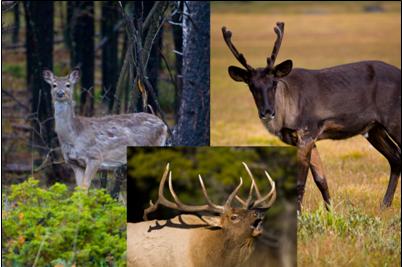Summary
Gastrointestinal (GI) nematodes can impact the health of ruminant hosts in subtle yet significant ways by altering body condition and fecundity. A current lack of baseline information on GI nematode diversity and distribution in northern cervids is of concern to northern wildlife managers, veterinarians and communities relying on country foods. Traditional parasite surveillance techniques are expensive, laborious and often require postmortem examination. In this study, we developed a rapid, noninvasive, fecal-based molecular tool to obtain baseline prevalence data for GI nematodes in western Canadian cervids. The purpose of this project was to delineate the species diversity and the distribution of parasitic gastrointestinal nematodes infecting caribou, elk and whitetail deer in north western Canada. This study ties in to the CircumArctic Rangifer Monitoring and Assessment (CARMA) Network as part of a study to monitor and assess the health of Rangifer throughout the circumpolar region.

Whitetail deer, caribou and elk are being assessed for gastrointestinal nematodes
Results
Cervids gastrointestinal (GI) tracts and/or fecal pellets were collected throughout the study area in partnership with numerous government agencies and northern communities. GI tracts were collected from various sources: roadkill, natural mortalities and hunted animals. Fresh fecal pellets were collected from the ground following visual observation of defecation or perennially during animal captures. For each sample the species of cervid, collection date, ecoregion and UTM were recorded. When available, additional attributes including the sex, age class, health status and cause of death for each cervid were gathered. Samples are being analyzed using molecular techniques (Single Strand Conformation Polymorphism) to describe the species diversity of GI nematodes in the study area. This information will be used to generate baselines of caribou parasite diversity in northern herds and to outline potential threats of pathogenic, northward expanding, nematodes in deer and elk.
To date, preliminary results show distinct patterns of overall infection prevalence and species diversity among caribou and other cervids. Caribou from all three ecotypes show high incidence of infection (82-100%) with one species (O. gruehneri). In southern regions where caribou and other species overlap in time and space, these data suggest limited parasite-host switching between caribou and other cervids.
Graduate Student, Nathan deBruyn in lab with nemotodes and eggs.
Applications
The diagnostic tool provides wildlife managers and veterinarians a non-invasive way to monitor herd health, ideal for threatened or endangered species.
Distribution and diversity baselines obtained during this study can be used to monitor for, and respond to, expected emergence of novel GI parasites in Canadian cervids associated with shifts in climate and land use.
Rapid and efficient diagnoses are a powerful means to mitigate against the spread of parasites into non-endemic regions during animal translocation.
Poster presentation presented at the CARMA 2008 meeting is available. Click here to download.
Contacts
Nathan deBruyn
Graduate Student
Faculty of Veterinary Medicine
University of Calgary
3330 Hospital Dr NW
Calgary, AB, Canada T2N 4N1
E: npdebruy 'at' ucalgary.ca
Tel: 403-210-7862
Susan Kutz
Associate Professor
Faculty of Veterinary Medicine
University of Calgary
3330 Hospital Dr NW
Calgary, AB, Canada T2N 4N1
E: skutz 'at' ucalgary.ca
Tel: 403-210-7862
